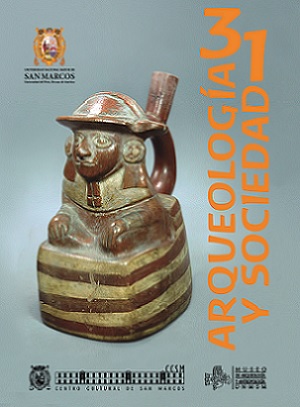EXCAVACIONES Y ESTUDIOS ETNOHISTÓRICOS DEL MONUMENTO ARQUEOLÓGICO SAN BORJA NORTE, VALLE DE LIMA
DOI:
https://doi.org/10.15381/arqueolsoc.2016n31.e13309Keywords:
San Borja Norte, archaeological monument, pre-Spanish, archaeological data, etnoshistorical dataAbstract
The San Borja Norte Archaeological Monument is a magnificent architectural testimony of the Pre-Tawantinsuyu Limatambo Urban Center, whose built area originated before the Spanish invasion was located between the current Canada Avenue and the former Limatambo airport.
The Archaeological Monument of San Borja Norte is built in adobon (rammed clay), with walls based on blocks imbricated by consecutive fixings solved in soft slope to the outside; Its elevation was achieved through the technique of filling internal compartments overlapped vertically, having interior medianero walls that buzz from north to south and east to west, serving as a restraint to such fillings. This external architecture is superimposed on the oldest of the average horizon in plant and rectilineal elevation is. The most visible to the outside is massive and technically repetitive in the monument. Its south, east and west external profiles, as well as a remittance of the heavily destroyed north face, show typical characteristics described. Between four and six outer walls consecutively on a smooth slope, they enclose, enclose and delimit the preserved internal architectural unit of seven meters high in the south-west angle. The walls with interlocking blocks are late interim architectural morphology and correlate with archaeological architectures of similar typification in other parallel markas settled in different courses of the Valley of Lima, sharing similar constructive techniques.
The Monument of San Borja Norte, as a local architecture belonging to the Lima marka comes to form part of Tawantinsuyu, suffering people the disorders typical of Cusco. It imposes the political and administrative institution called “Tambo” to function as a body of social and political control in the local order. This archaeological monument is the best preserved in the district of San Borja, land of the old archeological center pre-Spanish Limatambo.
Downloads
Published
Issue
Section
License
Copyright (c) 2017 Alberto Bueno Mendoza

This work is licensed under a Creative Commons Attribution-NonCommercial-ShareAlike 4.0 International License.
THE AUTHORS RETAIN THEIR RIGHTS:
a. The authors retain their trademark and patent rights, and also on any process or procedure described in the article.
b. The authors retain the right to share, copy, distribute, perform and publicly communicate the article published in the Arqueología y Sociedad (for example, place it in an institutional repository or publish it in a book), with an acknowledgment of its initial publication in the Arqueología y Sociedad.
c. The authors retain the right to make a subsequent publication of their work, to use the article or any part of it (for example: a compilation of their works, notes for conferences, thesis, or for a book), provided that they indicate the source. of publication (authors of the work, journal, volume, number and date).






